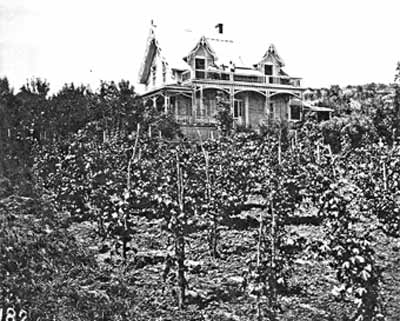Pioneer Profiles – July 2014 – “Father of Southern Oregon’s Orchard, Wine & Horticulture Industries”
In the mid-1800s, the promise of gold and free land lured fortune seekers and settlers to the newly-formed Oregon Territory. They were soon followed by merchants who amassed their own wealth selling supplies to the miners and farmers. This on-going series shares the stories of these pioneers and their times.
In June, Pioneer Profiles highlighted Peter Britt’s renown as photographer, artist, and documenter of pioneer life in Southern Oregon. However, Britt was also an avid gardener and is considered to be the father of Southern Oregon’s commercial orchard, wine, and ornamental horticulture industries. Britt Park, now the Britt Festival grounds and the City-owned lower Britt Gardens, was the focal point of many of these efforts.
When Britt arrived in Jacksonville in the fall of 1852, he camped on the site now known as “Britt Hill,” filed a donation land claim, and built a small log cabin with a magnificent view. Apparently Britt soon set about cultivating a garden on his property, and by 1854 had planted his first fruit tree and grape vines. Britt had been reared in the grape districts of Switzerland, and his travels in France had added to his knowledge of the grape industry. “Noting the vigor of the wild grape vines about here, he determined to give tame grapes a trial,” a 1920 Jacksonville Post article reported.
Family legend has it that Britt acquired his initial root stock from an Italian peddler from California. When he returned to his photography after his years of “mule skinning,” he established a vineyard and planted orchards of pears and peaches to supplement his income. By 1861 he had developed a 20-acre commercial orchard and expansive grape vineyards on a property he had purchased about a mile from Jacksonville.
Britt’s initial vines were Mission grapes, but by the 1870s he had experimented with over 200 varieties of American and European grapes, and furnished vines for every vineyard in Rogue River Valley. One of his experimental varietals may well have been pinot noir, and perhaps Jacksonville and not the Willamette Valley is the Oregon birthplace of the state’s famed wine.
However, Britt may not have sold pinot noir commercially. His records show that he made muscatel and zinfandel wines, as well as a popular claret which he marketed under his Valley View Vineyard label. By 1880 he was producing 1,000 to 3,000 gallons of wine per year, eventually filling orders from as far away as Wyoming.
Britt also produced and sold peaches, apples and pears. He was acquainted with knowledgeable horticulturalists throughout the country and stayed well-informed in the latest cultivation methods. He raised bees to improve pollination, and then sold the honey. He irrigated his property as early as 1855, installing an innovative irrigation system fed by a mile-long ditch and a system of underground pipes. He used smudging techniques to fight frost.
Beginning in 1859, he recorded weather observations in his personal diary, and when an official weather service was established within the Army Signal Core in 1870, Britt served as a volunteer civilian observer. Given Britt’s vast knowledge and experience, local agriculturists frequently sought his advice as they established their own commercial fruit crops.
Britt’s interest in horticulture also extended to exotic plants. As early as 1859, he began keeping a list of plant specimens he would like to grow and surrounded his home with ornamental shrubs, exotic trees, and unusual botanical specimens. What started as utilitarian plantings of pear and apple trees, grapes and vegetables, evolved into lavish Victorian gardens incorporating texture variation, unusual plantings, and tropical and Asian influences.
In the near-Mediterranean climate of the Rogue River Valley, Britt successfully cultivated lilies, ferns, magnolias, rhododendron, jasmine, forsythia, wisteria, roses, bamboo, palms, yucca, papyrus, gingko, figs, persimmons, and his famous banana tree. His orchards represented a selection of the best fruit trees that could be grown in the West and were designed to provide sequential harvesting. His gardens also boasted the oldest bay laurels in the state. They furnished the bay leaf seasoning for Jacksonville’s pioneer cooks.
Britt’s plantings eventually grew into extensive botanical gardens boasting nearly 300 varieties of cultivated plants, many acquired by mail order. Britt documented his plantings in his photographic work, and Britt Park was featured in northwest promotional publications in the late 1800s. The gardens were a regional attraction a quarter of a century before Ashland’s Lithia Park was established, and by the turn of the century, Britt’s gardens had become a Pacific Northwest tourist destination.
Today, the lower gardens have been restored by the City of Jacksonville, the Jacksonville Boosters Club, and the Jacksonville Garden Club. The upper gardens are home to the Britt Music Festival, and both upper and lower gardens provide key trailheads to the 18+ miles of Jacksonville Woodlands hiking trails. Britt Park is again a popular destination for residents and visitors alike.
Next month: Peter Britt, Home and Family.

Hi
I am a winemaker in the valley and would like to know if Peter Britt left any comments or drawings on how he cultivated his vineyards?
If so where can I read it
Thanks for any help